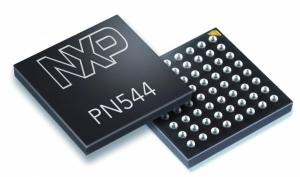NXP CEO: Google Has High Hopes for Android NFC Shipments

NFC phone shipments could approach 100 million units this year if Google’s rosy projections for Android NFC smartphone shipments come to pass, NXP Semiconductors CEO Richard Clemmer said during a conference call following release of the chip maker’s first quarter results.
The shipment total would include phones supporting all types of operating systems and using chips from all suppliers, not just Google’s Android platform or NFC chips from NXP.
The forecast is higher than NXP’s projection of 70 million NFC phones shipped from all suppliers that NXP made earlier this year. But Clemmer also warned yesterday that it’s too early to tell how many NFC phones will be on the market this year, since introductions are expected to “ramp in the back half of the year.”
Clemmer said NXP, the largest supplier of NFC chips, was sticking with the 70 million projection of phone shipments from all suppliers in 2011 for now. But he added low-end projections place shipments as low as 40 million phones.
“There’s going to be quite a bit of variability through the year,” Clemmer told financial analysts yesterday. “Every time we talk to our friends at Google, they tell us to double the numbers of Android expectations. So if the low-end happens, where new models don’t get pushed out, maybe it gets down to 40 or 45 million units this year. But if, in fact, Google’s right, and we should double everything, then the number is closer to 100 million.”
NFC Times has learned that, according to internal estimates, Netherlands-based NXP is supplying chips for about 40 phone models that are in the pipeline for release over the next several months. Clemmer did not mention those estimates during the conference call.
NXP is supplying chips for Android phones made by Samsung Electronics, including Google’s own Nexus S, as well as for ZTE and probably others building smartphones based on Android. It also designed the Android NFC phone software stack for Google. And it supplies NFC chips for phones using other platforms, including Symbian phones from Nokia.
Sticking With the Figures
Chief competitor Inside Secure is supplying NFC chips to Research in Motion for its roll out of NFC-enabled BlackBerrys and has received orders that could reach 25 million chips, NFC Times has learned.
NXP earlier projected shipments of NFC phones would hit about 150 million units in 2012. It has not disclosed projections further out. Clemmer did not change that projection either during yesterday’s conference call.
“We’re kind of sticking with our figures for now,” he said. “We’ll have a better feel when we get to the middle of the year for actual rollouts of the new implementations.”
 NXP said it generated $189 million from its Identification segment in the first quarter, up 17% from the fourth quarter of 2010 and a 40% jump from the first quarter of 2010. The unit includes sales of NFC and other contactless chips
NXP said it generated $189 million from its Identification segment in the first quarter, up 17% from the fourth quarter of 2010 and a 40% jump from the first quarter of 2010. The unit includes sales of NFC and other contactless chips
But most of the growth came from dual-interface chips for bank cards along with chips for contactless readers and electronic passports and ID cards.
In fact, sales of NFC chips were flat during the first quarter compared with the fourth quarter of 2010, Clemmer said.
He did not reveal the number of NFC chips NXP shipped during the first quarter, but earlier said that Q4 2010 shipments represented the first real spike in sales of NFC chips since NXP, then called Philips Semiconductors, launched the technology in 2002 with co-creator Sony Corp. The spike came from shipments to Samsung for Google’s Nexus S.
Clemmer has said that up until the fourth quarter of 2010, NXP had shipped a total of about 1 million NFC chips over the years. The chip maker shipped three to four times that number during the fourth quarter, he added, which would mean it also shipped roughly 3 million to 4 million chips during the first quarter of 2011.
While perhaps that Q1 figure is lower than expected, Clemmer said NXP was “encouraged by design wins” from handset makers to incorporate NXP chips into their phones.
“We believe there will be a significant ramp of new programs during the latter part of the year as NFC breaks out into the mainstream smartphone market,” he told analysts.
He mentioned NXP’s earlier announcement, made during the Mobile World Congress in February, that China-based telecom equipment maker ZTE would be incorporating NFC into its expanding line of global smartphones, including Android phones, and feature phones. Shipments of the NFC phones would start in the second quarter of 2011, Clemmer said during yesterday’s conference call, repeating information in the earlier press release.
But NFC-enabled phone shipments by ZTE, one of the largest handset makers worldwide, will depend on orders from operators and would not be a default feature, ZTE president and CEO Shi Lirong said at the Mobile World Congress, in response to a question from NFC Times.
Secure Elements Key
Clemmer during the conference call also tried to cast NXP as an NFC company, not just a supplier of NFC “radio” chips. He said that meant the company also supplies secure chips embedded in NFC phones and NFC software for the handsets.
“So when we talk about NFC, we’re talking about the secure element to be able to provide the bulletproof security, as well as the software to be able to facilitate that radio and the secure element associated with it,” Clemmer said in response to an analyst's question.
The strategy is key to NXP’s long-term prospects in the NFC industry. Within a few years, such suppliers of wireless chips for smartphones as Broadcom, Qualcomm, Texas instruments and CSR are expected to include an NFC interface and protocols in their combination wireless chips that also variously support Bluetooth, WiFi, GPS and FM radio.
Clemmer said that when that happens, NXP could still provide the secure elements for the phones.












